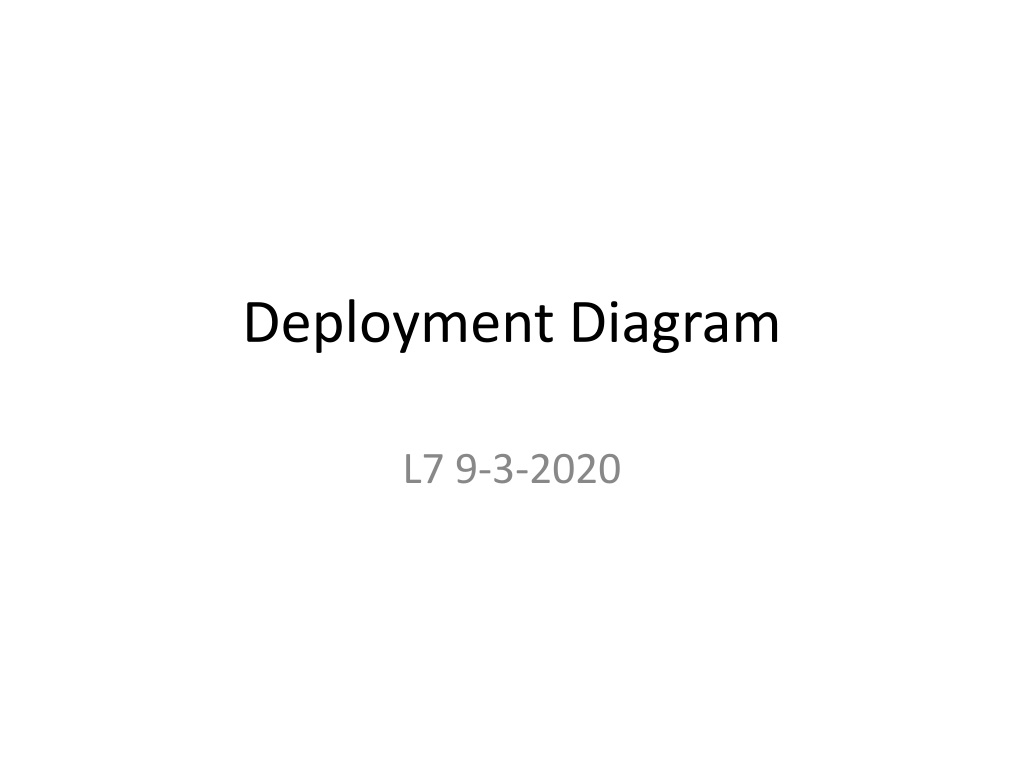Understanding UML Deployment Diagrams
UML Deployment Diagrams show the execution architecture of software systems, illustrating how software deployment targets are assigned artifacts to nodes. Nodes represent hardware devices or software environments connected through communication paths, while artifacts are concrete elements deployed on nodes. Components are deployed to nodes indirectly through artifacts in UML 2.x. The diagram includes various components like Deployment, Artifact, Association, Dependency, Component, Manifestation, Node, Device, and more.
Download Presentation

Please find below an Image/Link to download the presentation.
The content on the website is provided AS IS for your information and personal use only. It may not be sold, licensed, or shared on other websites without obtaining consent from the author. Download presentation by click this link. If you encounter any issues during the download, it is possible that the publisher has removed the file from their server.
E N D
Presentation Transcript
Deployment Diagram L7 9-3-2020
Deployment Diagram Deployment diagram is a static UML diagram which shows execution architecture of software systems that represent (deployment) of software deployment targets (usually nodes). the assignment artifacts to
Nodes and Artifacts Nodes represent either hardware devices or software execution environments. They could be connected through communication paths to create network complexity. Artifacts represent concrete elements in the physical world that are the result of a development process and are deployed on nodes. systems of arbitrary
How to use? In UML 2.x artifacts are deployed to nodes, and artifacts could manifest components. So components are now deployed to nodes indirectly through artifacts. (implement)
Components of Deployment diagram The following nodes and edges are typically drawn in a UML deployment diagram: Deployment, Artifact, Association Between Artifacts, Dependency Between Artifacts, Component, Manifestation, Node, Device, Execution Environment, Composition Of Nodes, Communication Path, Deployment Specification, Deployment Specification Dependency, Deployment Specification Association.
Artifacts manifest artifact Order.jar component Order artifact Order.jar In real life, an artifact is a concrete element in the physical world In the context of software development, an artifact is the specification of a physical piece of information such as a binary executable, a database table or an implemented component such as a DLL or a Java class file Each artifact has a filename An artifact is represented by a normal class rectangle with the keyword <<artifact>> or an artifact icon in the top right corner Name of artifact may (optionally) be underlined Artifact is said to manifest model elements that are used to construct the artifact Manifestation indicated by dependency arrow with keyword <<manifest>> 6
Manifestation Manifestation is an abstraction relationship which represents concrete physical rendering (implementation) of one or more model elements by an artifact In UML 2.0 and above, artifacts can manifest any package able elements (e.g., components)
A manifestation is notated in the same way as abstraction, i.e. as a dashed line with an open arrow head directed from artifact to packageable element, (e.g. to component or package) and is labeled with the keyword manifest .
EJB component UserService and skeleton of web services are manifested (implemented) by EJB module user-service.jar artifact
Manifest diagram as a deployment diagram While component diagrams show components and relationships between components , and deployment diagrams show deployments of artifacts to deployment targets, some missing intermediate diagram is manifestation diagram to be used to show manifestation (implementation) of components by artifacts and internal structure of artifacts.
Deployment Target and Node Artifacts are deployed to deployment targets. Deployment target is the location for a deployed artifact. A Node is a deployment target which represents computational resource upon which artifacts may be deployed for execution. Application Server Node
Node Node is specialized by: device execution environment So a deployment target (node) can be depicted as device (e.g. a hardware device) or as an execution environment (as a nested hierarchy of platform, operating system, and application softwares.) A node can also be shown as a hierarchical node if required
Execution environment Execution general node or device which represents the physical hardware environment on which this execution environment resides. Execution environments can be nested (e.g., a database execution environment may be nested in an operating system execution environment). environment is usually part of a Several execution environments nested into server device
Device A device is a node which represents a physical computational resource with processing capability upon which artifacts may be deployed for execution. A device is rendered as a node (perspective, 3- dimensional view of a cube) annotated with keyword device . UML provides no standard stereotypes for devices. Examples of non-normative stereotypes for devices are: application server client workstation mobile device embedded device
A communication path is association between two deployment targets, through which they are able to exchange signals and messages.
The physical layer LAN davesPC : PC susannesMac: Mac 54mbps wireless Deployment diagram shows The physical communication links between hardware items (nodes) (e.g., pcs, printers) The relationships between physical devices (nodes) and processes (artifacts) Physical layer consists of the machines, represented by nodes, and the (physical) connections between them (e.g., cables), represented by associations Nodes have node types 17
Deploying the software artifacts on the hardware nodes davesPC : PC susannesMac: Mac artifact LAN p1: PlayerInterface 54mbps wireless artifact p2: PlayerInterface artifact oxo: GameEngine Artifact shown inside a node to show that it runs on the node If an artifact depends on another artifact then there must be a physical link between the nodes on which they are deployed 18
Example: Deployment diagram of J2EE Web application
Example: Deployment diagram as Manifestation(diagram) for web application.
Example: Application deployment to Android. The manifest (deployment specification) file AndroidManifest.xml describes application requirements, such as the minimum version of Android required and any supported hardware configurations, and it also declares all components in the application.


 undefined
undefined





















